You searched for: austria
<< Previous | Displaying results 51-75 of 505 for "austria" | Next >>
-
Marie Sidi Stojka
ID CardMarie belonged to a tribe of Roma ("Gypsies") called the Lowara Roma who traveled in a caravan and made a living as itinerant horse traders. The caravan spent winters in Vienna, Austria's capital, and summers in the Austrian countryside. When Marie was 18, she married Karl Stojka from the same tribe. Marie's family was Roman Catholic and her ancestors had lived in Austria for more than 200 years. 1933-39: By 1936 Marie had six children. They lived with a caravan, and were used to freedom, travel and hard…
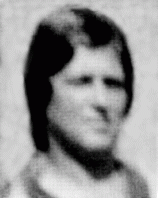
-
Gertrud Gruenbaum
ID CardBorn to a Jewish father and a Catholic mother, Gertrud grew up in Vienna. Trude, as she was affectionately called, attended a public secondary school, where half of her classmates were Jewish. At age 7 she rejected music lessons for classes in dancing and acting. Trude wanted to be like Greta Garbo. She launched an acting career at age 18, assuming the stage name Trude Hermann. 1933-39: Because Gertrud was Jewish she couldn't get acting jobs in Austria and nearby Sudetenland. In 1937 her agent found work…

-
Frieda Greinegger
ID CardFrieda was the fourth of five children born to strict Catholic parents. She had one brother and three sisters. Frieda grew up on a large farm near the village of Michaelnbach in northern Austria. The farm had cattle, horses, pigs and poultry, and the children worked long hours helping their parents on the farm. At age 12, Frieda left school to work full time on the farm. 1933-39: Germany annexed Austria in March 1938. When war broke out in September 1939, Frieda's brother was drafted into the German army.…
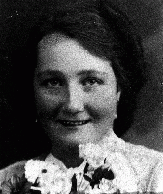
-
Frederick Dermer
ID CardFrederick was born to a Jewish family in the Austrian capital of Vienna. His father died when he was a baby, and he and his mother moved into an apartment with Frederick's widowed grandfather. As a young boy, Frederick attended a Viennese public school. 1933-39: Frederick was a rambunctious child. Once, when his grandfather was baby-sitting, Frederick used a silk lampshade as a "parachute," and jumped from the top of the wardrobe closet. That was the last time Frederick's grandfather would baby-sit.…

-
Lea Ofner-Szemere
ID CardLea was born in the city of Sombor in northeastern Yugoslavia. When she was 3 years old, her parents divorced and she moved to Vienna with her mother, who taught English and French to Austrian children. Lea enjoyed living in Vienna as a child. 1933-39: Lea returned to Sombor almost every year to visit her mother's relatives. There, she became reacquainted with her younger half-sister, Julia, and her older half-brother, Francis, and would miss them when she returned to Vienna. In 1938, the Germans annexed…

-
Ceija Stojka
ID CardCeija was the fifth of six children born to Roma ("Gypsy") parents who were Roman Catholic. The Stojka's family wagon traveled with a caravan that spent winters in the Austrian capital of Vienna and summers in the Austrian countryside. The Stojkas belonged to a tribe called the Lowara Roma, who made their living as itinerant horse traders. 1933-39: Ceija grew up used to freedom, travel and hard work. Once, her father made her a skirt out of some material from a broken sunshade. She was 5 years old and…

-
Hans Heimann
ID CardHans was born to a Jewish family in the Austrian capital of Vienna. His parents ran a successful export shop for ladies' hats and sold their wares to many different countries. As a boy, Hans attended a private, preparatory school in which courses were taught in both English and German. 1933-39: Hans was attending business school when the Germans annexed Austria in 1938. Hans and his family watched from their window as German troops, led by Hitler, goose-stepped into Vienna. Hans was immediately forced out…
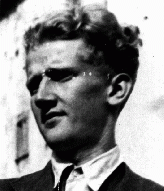
-
A crowd cheers Hitler in Vienna
PhotoA cheering crowd greets Adolf Hitler as he enters Vienna. Austria, March 1938. After a prolonged period of economic stagnation, political dictatorship, and intense Nazi propaganda inside Austria, German troops entered the country on March 12, 1938. They received the enthusiastic support of most of the population. Austria was incorporated into Germany the next day.

-
Corpses in Mauthausen
PhotoPiles of corpses, soon after the liberation of the Mauthausen camp. Austria, after May 5, 1945.
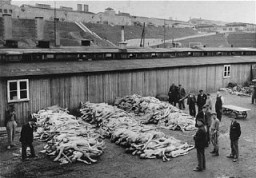
-
SS and Nazi police prepare for a raid
PhotoSS and Nazi police prepare for a raid on the Jewish community offices in Vienna. Austria, March 18, 1938.
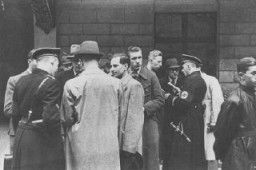
-
Mauthausen camp quarry
PhotoA view of the quarry at the Mauthausen concentration camp, where prisoners were subjected to forced labor. Austria, 1938-1945.
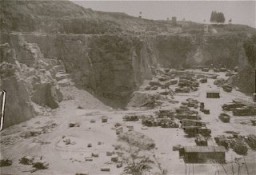
-
Bodies of victims of the Gunskirchen subcamp of Mauthausen
PhotoCorpses of victims of the Gunskirchen subcamp of the Mauthausen concentration camp. Austria, after May 5, 1945.
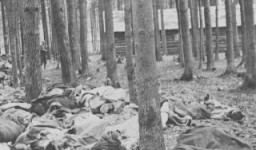
-
Mass grave at Mauthausen
PhotoA mass grave at the Mauthausen concentration camp. Photograph taken after the liberation of the camp. Mauthausen, Austria, May 10–15, 1945.

-
Romani (Gypsy) women in the Lackenbach camp
PhotoRomani (Gypsy) women march to work in the Lackenbach internment camp. Lackenbach, Austria, 1940-1941.
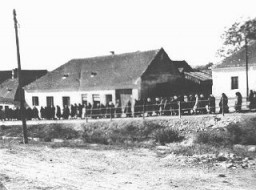
-
Storm Troopers stand guard outside a defaced Jewish-owned business
PhotoShortly after the German annexation of Austria, Nazi Storm Troopers stand guard outside a Jewish-owned business. Graffiti painted on the window states: "You Jewish pig may your hands rot off!" Vienna, Austria, March 1938.
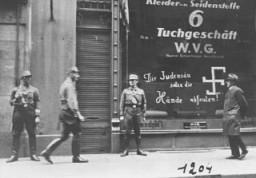
-
Public humiliation of Jews in Vienna
PhotoTwo Jewish men (center, and at right in overcoat), carrying paint and brushes, who were forced by Austrian Nazis to paint "Jude" on the fronts of Jewish-owned businesses. Vienna, Austria, 1938.
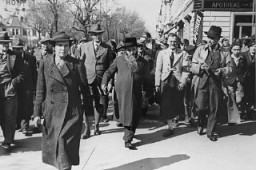
-
A Jewish man is forced to paint anti-Jewish graffiti on a storefront in Vienna
PhotoOnlookers watch as a Jewish man is forced to paint anti-Jewish graffiti on a shuttered storefront. Vienna, Austria, March 1938.
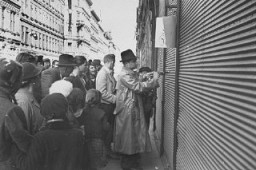
-
An SS officer standing in front of Jews assembled for deportation
PhotoAn SS officer stands in front of Jews assembled for deportation. Vienna, Austria, 1941-1942.
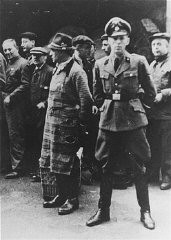
-
A pile of corpses in the Mauthausen concentration camp
PhotoA pile of corpses at the Russian Camp (Hospital Camp) section of the Mauthausen concentration camp after liberation. Mauthausen, Austria, May 5-15, 1945.

-
13-year-old survivor of the Mauthausen concentration camp
PhotoA 13-year-old orphan, a survivor of the Mauthausen concentration camp. Photograph taking following liberation of the camp. Austria, May 1945.
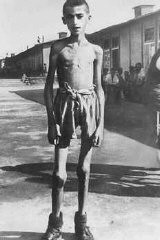
-
Hartheim castle euthanasia killing center
PhotoHartheim castle, a euthanasia killing center where people with physical and mental disabilities were killed by gassing and lethal injection. Hartheim, Austria, date uncertain.
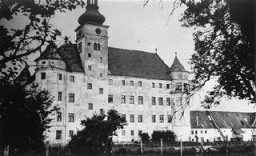
-
Ernst Reiter
ID CardErnst was an only child born to atheist parents in southern Austria during the middle of World War I. Raised in Austria's second largest city, he loved the outdoors, especially skiing in the Alps. In the early 1930s Ernst became a Jehovah's Witness. Although Austria was then in a deep economic depression, he was fortunate to find a job as a sales clerk in a grocery store. 1933-39: Austria's Catholic government was hostile towards Jehovah's Witnesses. When the Germans annexed Austria in March 1938, their…

-

-

-
Ossi Stojka
ID CardOssi was the youngest of six children born to Roma ("Gypsies") who traveled in a family wagon. His family was Roman Catholic. Their caravan spent winters in Vienna, Austria's capital, and summers in the Austrian countryside. The Stojkas belonged to a tribe called the Lowara Roma, who made their living as itinerant horse traders. Ossi's ancestors had lived in Austria for more than 200 years. 1933-39: Ossi was 2 years old when Germany annexed Austria in March 1938. The Stojka family wagon was parked for the…

